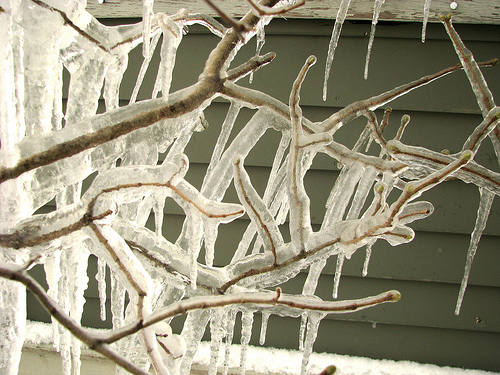The storms moving across the U.S. this week are bringing massive amounts of ice to many homeowners. This brings us to the question…What are the best methods for ice removal around the home? The goal is to keep your home functioning properly while making sure everyone is safe. But sometimes the process of removing the frozen stuff can leave your home damaged. Let’s take a look at the most important items affected by ice, discuss methods for inspection, and review removal when necessary.
Ice Removal on Concrete Walkways
Walkways can get extremely slippery when an ice storm rolls through the neighborhood. So what’s the best way to remove the ice? Avoid salt as it can damage both the concrete surface and other surrounding materials. Remember, removal and replacement of concrete surfaces will cost $6 to $8 per square foot…which can add up to thousands of dollars. For safe ice removal, look for deicers that won’t hurt concrete, landscaping, and pets if you have them. You will also want to look at the effective temperature range of the material to make sure it will work with the current conditions.
Sump & Downspout Discharge
Your sump pump will continue to run even when it’s below freezing outside because the ground temperature is well above freezing. If you have a sump pipe that discharges along the ground outside your home, be sure to inspect to make sure it’s clear. In extremely cold temperatures, ice can form on the end of the pipe which can limit the flow. If the obstruction becomes large enough, your basement may flood.
It’s also a good idea to inspect all downspouts that discharge onto the ground around your home. These downspouts are typically made out of metal, which can cause the water running through them to freeze and obstruct the flow. Even if there is only ice and snow falling from the sky, your attic and roof surface may be above freezing, causing melting to occur on the roof surface and flow into the downspouts.
Vents and Ice Removal
If you have any gas powered appliances, you probably have exterior vents that remove the dangerous byproducts from combustion. It’s extremely important to the safety of a home’s occupants to make sure these vents operate as designed. Inspect all of these vents including those from…hot water heaters, furnaces, kitchen rangehoods, dryers,…etc. If flaps or openings become frozen shut, the dangerous fumes can make their way back into the home.
Gutters & Icicles
Icicles can form on your gutters during an ice storm. If the actual icicles get big and heavy enough, they can damage your roofs drainage system. Large ice pieces can also be a safety concern for people on the exterior of your home. For these reasons, you should carefully remove any over sized pieces that can be safely remove while standing on the ground.
Roof Leaks from Ice Dams
Does your roof leak only during the cold winter months? You may be experiencing a problem created by ice dams. Roof ice dams can be caused by a number of different home problems including poor attic insulation and ventilation. To find out more about this problem, check out our previous article, Preventing Ice Dams.
Are you do for a new roof? If you have a major home improvement or building project coming up, be sure to stop by our eStore for some great money saving resources.


